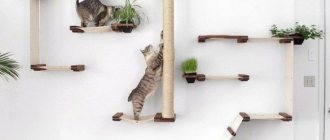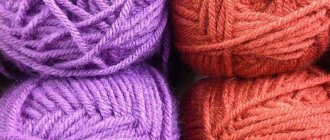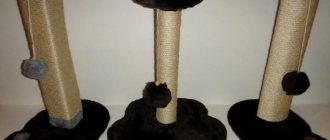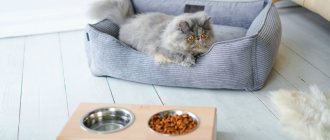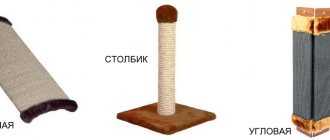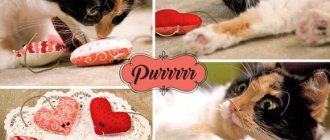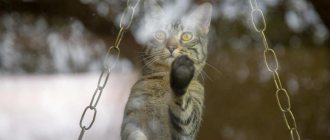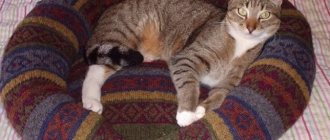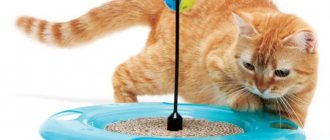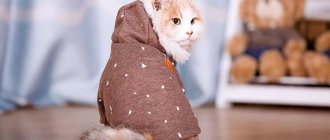A kitten in the house is always a source of joy and positivity, but it is important not to forget that the pet has its own needs. For example, a timely purchased scratching post will not only save furniture and wall coverings from sharp cat claws, but will also certainly please the kitten. In addition, do not forget that you can easily make a device from wood and strong rope yourself.
Making a scratching post
In specialized stores for animals you can find a wide variety of designs for sharpening claws - overhead, corner, in the form of labyrinths or simple columns. But a self-made scratching post has a number of advantages:
- Save money, since a hand-made design will cost several times less than one purchased in a store.
- For manufacturing and decoration, you can take any materials, taking into account what will fit into your interior.
- If you try, you can construct an entire play complex with a variety of columns, shelves and transitions. Such labyrinths are quite difficult to find in the store.
- The design details can be adjusted to the size of the pet. What is presented in specialized stores is produced according to standard sizes and does not always fit the size and age of the animal.
In order to make a regular scratching post, you only need two things - a post and a rope. We'll talk about what rope to use for the scratching post a little later.
Basic rules for reliable installation
An important requirement for any scratching post is its correct fastening. A scratching post with your own hands must support the weight of the cat, and not tip over, and have a stable base. If the fastening is weak, the animal will be able to knock it over, this may lead to the fact that the pet will begin to be afraid of it and after this incident will not use it. The base must be calculated taking into account the height and body weight of the animal. There are a few tricks to getting your cat to like this new piece of furniture. To do this, it is recommended to treat the jute rope for the scratching post with mint or catnip leaves. It should not be treated with valerian.
Most cats prefer to sharpen their claws in the morning, so it is better to place it near their sleeping place (ideally, make a bed or house equipped with a post with a jute winding). If possible, it is recommended to place a new scratching post in those places where the cat was accustomed to sharpening its claws before its appearance. To make it clear how to make a scratching post on your own at home, you can watch a video of making a scratching post.
Types of scratching posts
What kind of scratching post you get as a result depends only on your desire, skills and the amount of time spent on its manufacture. To make the simplest standard structure in the form of a column covered with rope, it will take a maximum of an hour. If you decide to put together an interesting gaming complex for one or several pets, then you will have to work hard and allocate much more time for this.
The simplest version of the play complex consists of several posts and a shelf fixed on top where the pet can rest. The remaining details depend only on your imagination.
Anti-vandal fabrics
Modern manufacturers meet the wishes of pet owners and produce special materials that can be used to protect upholstered furniture from the sharp claws of a pet. Scope of application of anti-vandal fabrics:
- as furniture upholstery materials;
- for removable covers;
- when making a sleeping place for a pet.
What to sew a cat bed from or make an unusual homemade ottoman? We list several of the most popular options for anti-claw fabrics:
- Flock. This two-layer fabric is combined from natural and polymer fibers and impregnated with a special compound that increases strength and resistance to wetness. The outer fibers have a long-lasting color and are resistant to stains. To remove dirt, simply wipe the flock with a damp cloth. For long-term use, the fabric can be washed in a washing machine. The fabric surface is smooth, so cat claws cannot catch and pull out the fibers. It is recommended to vacuum this material frequently, since flock is easily electrified (like any synthetics) and attracts dust.
- Relax is a combined synthetic fabric in which a base of cotton and polyester is covered with a layer of isoprene. Thanks to this composition, the fabric invariably retains a neat and elegant appearance and lasts for many years, requiring virtually no maintenance. Elastic material cannot be scratched. Dirt from the surface of the relaxation area can be easily removed with soapy water.
- Faux suede consists of two layers. The base is a mixed fabric made of cotton and polyamide, and the top fleecy layer is polyester. The advantage of this material is the absence of electrification and permeability to air. Wet cleaning and washing are not permitted. In case of severe contamination, you will have to invite specialists in chemical cleaning of furniture. Unfortunately, faux suede is not very durable, so a diligent cat can tear this fabric.
- Microfiber is a synthetic fabric formed by interweaving thin artificial threads. Typically, manufacturers impregnate the fabric with Teflon, which makes the material tear-resistant. This durable material is easy to care for: it can be machine washed and wet cleaned with a wet sponge.
- Tapestry fabric is a dense material formed by the interweaving of thick threads. The tapestry looks stylish and expensive. The only drawback is that the tapestry is afraid of ultraviolet radiation and easily loses its original shade in direct sunlight.
- Scotchgard is a jacquard weave fabric with water-repellent impregnation. This canvas is well protected from damage and always retains its original bright pattern. Allows dry cleaning, wiping with soapy water or a special cleaning agent.
The play complex was made by ourselves for kittens
Cattery kittens on a homemade three-story scratching post complex with beds, a house, and a hammock
How much rope will be needed?
Any modern rope for a scratching post has a high degree of strength and is resistant to tearing, which makes it an ideal material in this case. Before proceeding with the manufacture or replacement of this element, it is necessary to calculate the length that will be required.
There are two ways to measure footage:
- Using old rope for a scratching post. In this case, you need to remove the rope from the old post, measure its length, or take the rope with you to the store so that the consultant can help you choose the material and footage.
- Calculation using a special formula:
Rope length = (post height/rope diameter) * 3.14 * post diameter.
For example, there is the following data:
- The height of the column is 100 cm, its diameter is 10 cm;
- Rope diameter – 0.8 cm.
From here we get: rope length = (100/0.8) * 3.14 * 10 = 3925 cm, that is, 39.25 m.
The optimal rope diameter is considered to be 8 mm, but 6 mm is quite suitable for making a scratching post.
How to make a scratching post with your own hands
This type of design is the most common among cat owners. It does not need to be equipped with a house; it is a separate piece of furniture. You can make such an accessory entirely on your own, without spending a lot of money, effort and time. To make it, you will need a piece of chipboard, which will become its base. If you don't have one, an old countertop or any other flat piece of wood that is wide and thick enough will do.
You can choose almost any shape of the scratching post itself - square, oval, round, any other. The main requirement for her is to be resilient. The base is covered with jute, which is well secured on the sides, and then wound vertically, moving in a spiral.
The post itself can be made from PVC pipe, but a wooden beam with a cross-section of at least 10 cm can also be used. To give the structure massiveness and better stability, you can weight the base with additional weight.
Which rope is better to choose?
The choice of ropes is very large, but the main thing you need to pay attention to when choosing is natural fibers. Environmentally friendly materials of natural origin are the best ropes for scratching posts; they are completely safe for both animals and people, are not electrified and will not harm the pet. A cat will definitely like a scratching post coated with natural fiber, which cannot be said about a purchased one made from artificial rope. Some pets may be put off by the synthetic smell, as well as the presence of paint and impregnation.
Polypropylene and nylon ropes are several times stronger than natural ones, but they tend to stretch, and cat's claws can get tangled and stuck in the fibers of the material.
A hemp rope wrap for a scratching post will not last long; the material will quickly fluff due to fragments of fibers.
Why do cats need a scratching post?
The domestic kitty traces its origins to wild creatures that had an extensive set of instincts. Claws serve to implement the natural functions inherent in all representatives of the cat family. Cat claws carry a multifunctional load:
- used for climbing trees;
- help with hunting;
- protect from attacks by aggressors;
- maintain balance when walking or jumping;
- promote the release of odorous secretion from the finger pads to mark the boundaries of the territory.
In the natural environment, cats sharpen their claws on hard objects: pebbles, tree bark, dry plants. Pets do not need to hunt to get food. Maintaining normal nail length continues to be an urgent need for cats, as long nails will cause pain when moving. A cat, driven by instincts, always finds an object to fulfill its natural needs. Usually, upholstered furniture (sofa, armchairs), carpet pile and wallpaper are affected. An easy way to save your home furnishings from destruction is to purchase a device for sharpening cat claws.
Types of ropes
The question of what cat scratching posts are made of worries many owners who have decided to please their pet. There are several of the most common types of rope for a scratching post that can be used to wrap a post:
- Cotton rope. This material looks great and fits perfectly into any interior, but is much more expensive than other types.
- Sisal rope. Its cost is much lower, the structure is fleecy, the material is quite strong, durable with a grayish or pale yellow tint.
- Jute rope. This material is most often used in scratching posts that are sold in stores. Jute rope for scratching posts is the cheapest, but has less strength compared to previous materials.
All these materials differ radically from each other in a number of basic parameters, which primarily determine how long the scratching post will last. Therefore, next we will look at what ropes for scratching posts are called and compare their types to make it easier to systematize the information for the right choice.
Option #1. Cardboard scratching post: the simplest
Let's start with the simplest and most budget option - a cardboard sharpener. It can be done if a small kitten has just appeared in your house. Moreover, you can complete the production of the product in literally half an hour.
Step 1 . Take regular cardboard packaging boxes with wide and fairly thick corrugation (look at the end of the box wall and you will understand what we are talking about). Take them apart.
Preparing cardboard boxes
Step 2 . Using a ruler and marker, draw each box into 12 cm wide strips.
Stripes 12 cm wide are drawn
Step 3 . Using the same ruler and utility knife, cut the cardboard into strips along the previously drawn lines. Cut the cardboard on a solid base that you don't mind damaging, or use scissors.
Cardboard is cut into strips
Step 4 . Start rolling individual pieces of cardboard into a tube, making turn after turn.
The pieces are rolled into a tube
Step 5 . To prevent the cardboard from unwinding, secure the individual strips with tape or glue.
Individual lanes need to be fixed
Step 6 . When you get the “bobbin” of the desired size, you can stop winding. You will get a large cardboard scratching post that your cat will definitely appreciate.
DIY cardboard scratching post for cats
What to choose - jute or sisal fiber?
So, both types are popular due to their affordable cost. This factor is quite significant, because winding a post requires several tens of meters of rope. But you should immediately pay special attention to the fact that no matter what material you choose, the scratching post will not last forever! Any thing wears out over time, and this product is no exception. The lifespan of the scratching post depends on the following parameters:
- How often does the pet use it?
- Breed of the animal (large representatives have a much larger nail plate).
- The quality of the scratching post.
Jute is made from the plant of the same name in the mallow family. Its fibers are mainly used in the textile industry, as well as for making ropes and burlap. Features of jute:
- Gray-brown fiber color.
- Softness.
- Smoothness (fibers do not stick out).
- Low cost compared to similar materials.
Sisal rope is much coarser than jute because it is made from raw fibers obtained from the leaves of the agave tree. This plant has unique qualities, which allows it to be used in a wide variety of industries, from food to construction. What features does sisal have?
- Quite a rigid structure.
- Light sandy shade.
- High wear resistance.
Base options
Item needed:
- strong enough to support the weight of the animal;
- lightweight so that bulky structures are not required for mounting to the wall;
- Receptive to glue well, good for processing with tools.
Cheapness is an important parameter, but not as much as for coating. The base is expected to last a long time. Is this always necessary? Assess the complexity and wear time of the craft. It may turn out that it is more rational to replace it completely than to remove the glue.
For the base take:
- plastic water and sewer pipes - they are easily sawed across and lengthwise, it is easy to make a frame of any shape from them with reliable fastenings from standard adapters;
- pieces of plywood of various thicknesses;
- sections of tree branches after sanitary pruning at the dacha (necessarily healthy fragments, so as not to bring pests into the house).
The branches can also be used for decoration: a cat lying on them, attached to the ceiling, will decorate any apartment.
Hemp for scratching post
If you just can’t choose or for some reason don’t want to purchase sisal and jute rope, then you can consider another option for wrapping the scratching post - hemp threads. This material is made from hemp plants, which do not contain narcotic substances. The fibers are used in the production of fabrics and ropes. Although jute and sisal ropes are favored by pet product manufacturers, hemp is just as good, proving that hemp remains an important resource in the industry. New fibers are also mistakenly called hemp - sisal, jute and others. So, let's look at the advantages of hemp threads:
- A variety of colors (the shade can be absolutely any, depending on the processing method).
- Has an average price.
- Its properties are superior to jute rope.
- High strength.
- Resistance to environmental influences.
- High hygroscopic and anti-electrostatic properties.
About the dangers of declawing
It is in this operation that people see the solution to their problems with an unruly animal, forgetting about the irreparable harm that is caused to the cat.
Without claws, a pet becomes disabled, cannot move normally, and will have to literally learn to walk again, shifting the center of gravity from the toes to the heel. This is equivalent to cutting off a person's toes. This operation has a detrimental effect on the pet’s musculoskeletal system, problems with internal organs are possible, not to mention the fact that declawing will completely “unbalance” the cat, making it insecure and fearful. Once outside, such an animal is unlikely to last long.
Fortunately, many veterinary clinics are categorically against onychectomy and refuse this service to owners who apply.
Requirements for a homemade design
Store-bought copies often do not shine with practicality. The main drawback of many models is instability. Therefore, the first important criterion for a DIY scratching post is its reliability. The design must also:
- not too bulky, which is especially necessary for small apartments;
- be durable - very durable, made of high-quality materials;
- have a nice appearance, since it will not be the last element of the interior.
Some purchased scratching posts may meet these requirements, but these models are a direct path to emptying your wallet. Their other drawback is synthetic materials, the “aroma” of which delicate cat noses are not able to get used to.
The naturalness of all materials is another mandatory condition if the owners want the pet not to reject what was done with backbreaking labor. You need to use wood, natural materials, cardboard packaging, burlap, twine.
Correct installation of a scratching post, how to accustom a cat to it
An experimental method will help you find the right place for a new piece of furniture: move the scratching post until the cat shows interest. It is better to place it in a sunny place - where the fidget loves to lie, or in front of a scratched sofa or table. You shouldn’t put the accessory in the far corner - the pussy won’t like it, it will find the thing closer, and the gift will simply be ignored. Securely fasten the scratching post - it should not wobble if the cat sharpens its claws on it.
To teach your cat to sharpen her claws, take her by the paws and gently move her along the surface, provide the new item with the smell of her favorite treat, or place your things nearby - the smell of the owner is always attractive. When your lesson is learned, praise the pussy and give it a treat. And to wean you from scratching other objects, cover them with double-sided tape.
A cat scratching post should be in every home where a furry pet lives. Without this attribute, you won’t be able to achieve healthy nails, your furniture will be hopelessly damaged, and your pussy will be on you to relieve stress. You should definitely buy a cat scratcher, or make one yourself - this method will significantly save your budget.
Detailed job description
List of necessary materials for the kitty corner:
- rectangle made of fiberboard (40*122 cm);
- rectangle made of chipboard (44*61 cm);
- 2 rectangles made of chipboard (55*44 cm);
- rectangle made of chipboard (44*30 cm);
- wooden slats - 7 pieces (3*4*37 cm);
- pipe with a diameter of 110 cm, length 60 cm;
- 2 wooden blocks;
- rope diameter 11 mm, 15 meters in length;
- thin fabric or rope for an inclined climbing frame;
- self-tapping screws;
- 2 pieces of rectangular foam rubber (44*30 and 33*36 cm);
- heat gun;
- faux fur (2 square meters);
- toys;
- jigsaw;
- saw;
- screwdriver;
- drill;
- compass;
- stapler for furniture;
- roulette;
- sharp scissors;
- sandpaper;
- pencils or chalk.
First you need to cut out rectangles of the required size from fiberboard and chipboard. In the rectangles that are set aside from the wall, make truncated circles with a radius of 26 cm. To do this, draw a figure with a compass, which will then be cut out. It is best to make drawings on paper in advance.
We only need one circle. To enter the house on the right, make a circle. Dimensions: 21 cm in diameter.
Then draw three circles, each with a diameter of 5 cm, to create an imitation of a cat’s paws, as in the photo:
Next, make all the holes with a jigsaw, place the circles one on top of the other, mark seven points on one and the second wall.
Now you need to drill holes in two walls using a thin drill, or screw in a self-tapping screw and unscrew it. Then drill small holes for self-tapping screws on both walls at the attachment points. Saw off seven slats with a rectangular cross-section. Fasten the walls with screws and slats.
Types of complexes
The complexes are the most expensive and at the same time expedient purchase for your graceful, handsome man. Such adaptations are always made taking into account three characteristics of cats - the instinct of a hunter, the love of climbing in high places and the absence of boredom. There are the most original and unexpected combinations of complexes. They can consist of beds, scratching posts, platforms and shelves, steep stairs, and there must be a house in it. All this makes up a complete complex for entertaining cats.
The more complex and higher the device itself, and the greater the number of options for placing parts, the longer the interest in the complex of your home hunter will be. For example, Pet Salon, Trixie and others, it would seem, take the very essence of the cat as the basis for various complexes. The Catrix product is a product of the global market, boasting unique complexes in terms of convenience and functionality. Of course, the manufacturers themselves position it as a scratching post; in fact, it is quite possible to classify it as one of the most impressive and versatile gaming systems.
For the owners, such a complex may be reminiscent of a Lego set, since it is assembled using carefully thought-out parts.
Selecting size and shape
Regarding the size of the scratching post, there are certain standards in this regard: the larger the pet, the larger the scraper should be. Product parameters directly depend on the size of the cat
This is especially important for wall models, so that the cat does not scratch the wallpaper while sharpening its claws. The width of the claw blade in this case should be equal to the width of the animal’s outstretched paws
You can calculate the length of the scratching post by adding 5-10 cm to the length of the cat itself (excluding the tail).
For Maine Coons, the height of the vertical nail bed should not exceed 100 cm, especially if there is a bed on top. This is necessary in order to remove excess load from the front paws when jumping. For a kitten, make a scratching post “for growth”, focusing on its approximate future size as an adult.
The variety of scratching post models is simply amazing. There are 2 main types of scratchers: floor and wall (or hanging). There are many variations within each type. Thus, floor scratching posts can be flat (located horizontally or at an angle), in the shape of a column, equipped with additional beds, stairs, bridges and houses. The more cats there are in the house, the more elements the scratcher should consist of.
Note to the home handyman
There are many materials on sale that are suitable for making such products. The costs will be minimal:
- Cardboard cylinders left over from selling linoleum are great for making posts and columns.
- And to make a cat house, it is advisable to have a sheet of plywood or chipboard.
- To make it comfortable for the animal to climb, it is advisable to cover the products with carpet or thick fabric. In addition, they look much more fun and elegant. You can combine a scratching post and a cat house in a single complex.
Important! For a small apartment with very little space, a good solution would be to combine an ordinary bookshelf and a cat bed. In this case, the shelves need to be placed in the form of a “ladder” so that the domestic animal can move freely.
Pros and cons of scratching posts
| View | pros | Minuses |
| Scratching posts-houses | average price Combines a house | Takes up space When the coating wears out, you have to throw it away or retighten it. If the house is located below, it can become a toilet |
| Complexes for cats | High price Activities that are good for your cat's health | Takes up a lot of space When the coating wears out, you have to throw it away or retighten it. If the house is located below, it can become a toilet |
| Scratching posts | Not a high price No need to attach to the wall | Takes up space When the coating wears out, you have to throw it away or retighten it. |
| Wall mounted | Very low price Space saving Can be hung at any height Can be mounted on almost any vertical surface | Needs to be attached to the wall When the coating wears out, you have to throw it away or retighten it. |
| Horizontal (floor) | Low price No need to attach to the wall Exists in the form of rugs (bedding) | When the coating wears out you have to throw it away. |
